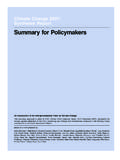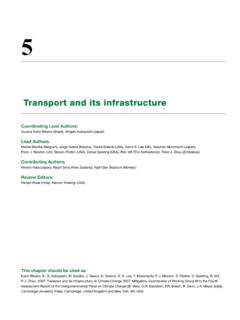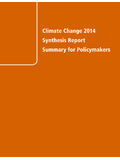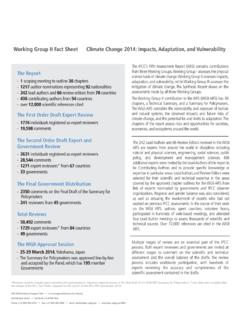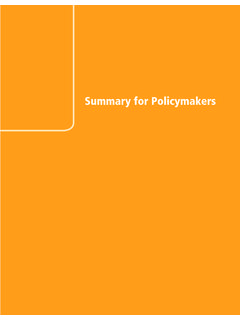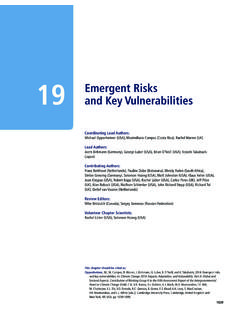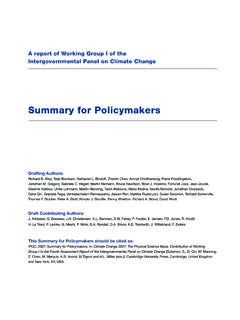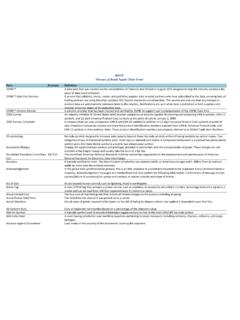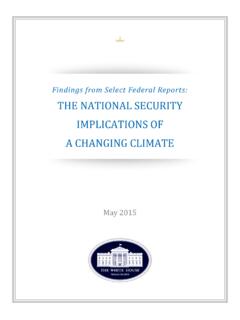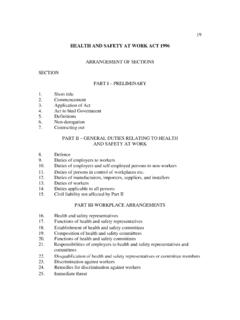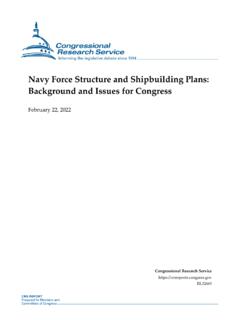Transcription of Buildings - Intergovernmental Panel on Climate Change
1 9 Buildings Coordinating Lead Authors: Oswaldo Lucon (Brazil), Diana rge-Vorsatz (Hungary). Lead Authors: Azni Zain Ahmed (Malaysia), Hashem Akbari (USA / Canada), Paolo Bertoldi (Italy), Luisa F. Cabeza (Spain), Nicholas Eyre (UK), Ashok Gadgil (India / USA) , L. D. Danny Harvey (Canada), Yi Jiang (China), Enoch Liphoto (South Africa), Sevastianos Mirasgedis (Greece), Shuzo Murakami (Japan), Jyoti Parikh (India), Christopher Pyke (USA), Maria Virginia Vilari o (Argentina). Contributing Authors: Peter Graham (Australia / USA / France), Ksenia Petrichenko (Hungary), Jiyong Eom (Republic of Korea), Agnes Kelemen (Hungary), Volker Krey (IIASA / Germany). Review Editors: Marilyn Brown (USA), Tam s P lv lgyi (Hungary). Chapter Science Assistants: Fonbeyin Henry Abanda (UK), Katarina Korytarova (Slovakia). This chapter should be cited as: Lucon O.
2 , D. rge-Vorsatz, A. Zain Ahmed, H. Akbari, P. Bertoldi, L. F. Cabeza, N. Eyre, A. Gadgil, L. D. D. Harvey, Y. Jiang, E. Liphoto, S. Mirasgedis, S. Murakami, J. Parikh, C. Pyke, and M. V. Vilari o, 2014: Buildings . In: Climate Change 2014: Mitiga- tion of Climate Change . Contribution of Working Group III to the Fifth assessment Report of the Intergovernmental Panel on Climate Change [Edenhofer, O., R. Pichs-Madruga, Y. Sokona, E. Farahani, S. Kadner, K. Seyboth, A. Adler, I. Baum, S. Brunner, P. Eickemeier, B. Kriemann, J. Savolainen, S. Schl mer, C. von Stechow, T. Zwickel and Minx (eds.)]. Cambridge University Press, Cambridge, United Kingdom and New York, NY, USA. 671. Buildings Chapter 9. Contents Executive Summary 675. 9. Introduction 677. New developments in emission trends and drivers 678. Energy and GHG emissions from Buildings 678.
3 Trends and drivers of thermal energy uses in Buildings 681. Trends and drivers in energy consumption of appliances in Buildings 683. Mitigation technology options and practices, behavioural aspects 686. Key points from AR4 686. Technological developments since AR4 686. Exemplary new Buildings 687. Energy intensity of new high-performance Buildings 687. Monitoring and commissioning of new and existing Buildings 688. Zero energy / carbon and energy plus Buildings 689. Incremental cost of low-energy Buildings 689. Retrofits of existing Buildings 690. Energy savings 690. Incremental cost 690. Appliances, consumer electronics, office equipment, and lighting 690. Halocarbons 692. Avoiding mechanical heating, cooling, and ventilation systems 693. Uses of biomass 693. Embodied energy and building materials lifecycle 694. Behavioural and lifestyle impacts 694.
4 672. Chapter 9 Buildings Infrastructure and systemic perspectives 696. Urban form and energy supply infrastructure 696. District heating and cooling networks 696. Electricity infrastructure interactions 697. Thermal energy storage 697. 9. Path dependencies and lock-in 697. Climate Change feedback and interaction with adaptation 697. Costs and potentials 699. Summary of literature on aggregated mitigation potentials by key identity 699. Overview of option-specific costs and potentials 702. Costs of very high performance new construction 702. Costs of deep retrofits 704. assessment of key factors influencing robustness and sensitivity of costs and potentials 704. Co-benefits, risks and spillovers 705. Overview 705. Socio-economic effects 705. Impacts on employment 705. Energy security 707. Benefits related to workplace productivity 707.
5 Rebound effects 707. Fuel poverty alleviation 708. Environmental and health effects 708. Health co-benefits due to improved indoor conditions 708. Health and environmental co-benefits due to reduced outdoor air pollution 709. Other environmental benefits 709. Barriers and opportunities 709. 673. Buildings Chapter 9. Sectoral implication of transformation pathways and sustainable development 710. Introduction 710. Overview of building sector energy projections 710. 9 Key mitigation strategies as highlighted by the pathway analysis 712. Summary and general observations of global building final energy use 714. Sectoral policies 715. Policies for energy efficiency in Buildings 715. Policy packages 718. A holistic approach 718. Emerging policy instruments in Buildings 719. New developments in building codes (ordinance, regulation, or by-laws) 719.
6 Energy efficiency obligation schemes and white' certificates 719. Financing opportunities 720. New financing schemes for deep retrofits 720. Opportunities in financing for green Buildings 720. Policies in developing countries 721. Gaps in k nowledge and data 721. Frequently Asked Questions 722. References 723. 674. Chapter 9 Buildings Executive Summary all stages of the building and appliance lifecycle and use, plus new business and financial models are essential. [ , ]. In 2010 Buildings accounted for 32 % of total global final There is a broad portfolio of effective policy instruments avail- energy use, 19 % of energy-related GHG emissions (including able to remove these barriers, some of them being implemented electricity-related), approximately one-third of black carbon also in developing countries, thus saving emissions at large emissions, and an eighth to a third of F-gases (medium evidence, negative costs (robust evidence, high agreement).)
7 Overall, the his- 9. medium agreement). This energy use and related emissions may dou- tory of energy efficiency programmes in Buildings shows that 25 30 %. ble or potentially even triple by mid-century due to several key trends. efficiency improvements have been available at costs substantially A very important trend is the increased access for billions of people lower than marginal supply. Dynamic developments in building -related in developing countries to adequate housing, electricity, and improved policies in some developed countries have demonstrated the effec- cooking facilities. The ways in which these energy-related needs will be tiveness of such instruments, as total building energy use has started provided will significantly determine trends in building energy use and to decrease while accommodating continued economic, and in some related emissions.
8 In addition, population growth, migration to cities, cases, population growth. building codes and appliance standards with household size changes, and increasing levels of wealth and lifestyle strong energy efficiency requirements that are well enforced, tightened changes globally will all contribute to significant increases in building over time, and made appropriate to local Climate and other conditions energy use. The substantial new construction that is taking place in have been among the most environmentally and cost-effective. Net developing countries represents both a significant risk and opportunity zero energy Buildings are technically demonstrated, but may not always from a mitigation perspective. [Sections , ] be the most cost- and environmentally effective solutions. Experience shows that pricing is less effective than programmes and regulation In contrast to a doubling or tripling, final energy use may stay (medium evidence, medium agreement).
9 Financing instruments, poli- constant or even decline by mid-century, as compared to today's cies, and other opportunities are available to improve energy efficiency levels, if today's cost-effective best practices and technologies in Buildings , but the results obtained to date are still insufficient to are broadly diffused (robust evidence, high agreement). The technol- deliver the full potential (medium evidence, medium agreement). Com- ogy solutions to realize this potential exist and are well demonstrated. bined and enhanced, these approaches could provide significant further Recent advances in technology, design practices and know-how, cou- improvements in terms of both enhanced energy access and energy pled with behavioural changes, can achieve a two to ten-fold reduction efficiency. Delivering low-carbon options raises major challenges for in energy requirements of individual new Buildings and a two to four- data, research, education, capacity building , and training.
10 [ ]. fold reduction for individual existing Buildings largely cost-effectively or sometimes even at net negative costs. New improved energy efficiency Due to the very long lifespans of Buildings and retrofits there is technologies have been developed as existing energy efficiency oppor- a very significant lock-in risk pointing to the urgency of ambi- tunities have been taken up, so that the potential for cost-effective tious and immediate measures (robust evidence, medium agree- energy efficiency improvement has not been diminishing. Recent devel- ment). Even if the most ambitious of currently planned policies are opments in technology and know-how enable construction and retrofit implemented, approximately 80 % of 2005 energy use in Buildings of very low- and zero-energy Buildings , often at little marginal invest- globally will be locked in' by 2050 for decades, compared to a sce- ment cost, typically paying back well within the building lifetime (robust nario where today's best practice Buildings become the standard in evidence, high agreement).

